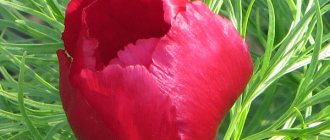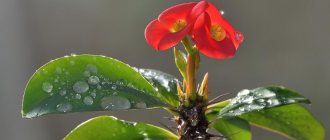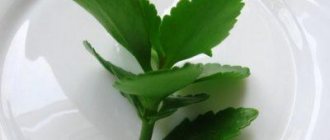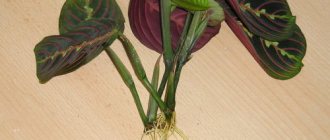Euphorbia Mile (Euphorbia Mile, Vulcanos, Brilliant) is an unusual, ornamental plant, a frequent resident of city apartments and country estates. This flower is very beautiful; people call it the “crown of thorns.”
It received this name due to the fact that its branches are round and thorny . Euphorbia does not require special care. And he always pleases with his appearance. Next, we will consider whether this plant can be kept at home and how to care for it.
What does Euphorbia Mila look like, what family does it belong to?
Euphorbia milius species is a succulent. In its homeland, under natural conditions, it reaches large sizes with abundant branching. The stem has a gray tint, slightly silvery. At the top of each shoot, light green leaves about 3.5 cm long are formed. Each leaf blade has several stipules that turn into sharp spines. The leaves fall off over time, but the spines remain on the plant. For this reason, leaves are formed only at the top of the shoots.
Euphorbia Mila in bloom in different shades
The bracts are painted in bright colors - yellow, orange, red. These plates are 12mm wide and round in shape. The inflorescences form several groups of flowers, which are surrounded by bright bracts. The inflorescences are bizarre, they are woven together with spines on long stalks.
Common varieties
There are main varieties that have different colors of inflorescences. Among them:
- Sakura kiss – white flowers with pink splashes;
- King yellow – solid yellow inflorescences;
- Moonlight – yellow flowers with an orange center;
- Natali – pink inflorescences, periodically there are dark stripes;
- Sonora – characterized by bright pink bracts.
Medicinal properties
The sap of the plant is poisonous. The composition of this liquid includes rubber, quamarines, resins, malic acid and euphorbion.
Important! In small doses, this composition has a beneficial effect on the human body.
Large milkweed needles
The juice is used to treat abrasions and wounds, as it has a healing and disinfecting effect. Before use, you need to carefully evaluate the likely benefits and harms of using this plant.
Briefly about the history of appearance
The governor of Reunion Island brought Mila to France back in 1821. The plant came to Europe from Madagascar and Africa. By nature it is a mountain flower.
Reproduction methods
There are several options for propagating milkweed. This allows each gardener to choose the best option.
Cuttings
This is the simplest method. It is recommended to take cuttings from an adult plant that has strong and thick shoots. To root the planting material, it should be placed in water to remove the milky juice.
After this, the plant should be dried. It is recommended to plant the crop in moist soil and cover it with film.
Place the pot in a bright place and provide the plant with a temperature of at least +20 degrees. After a week, it is recommended to water the crop. It is worth considering that rooting cuttings in water is prohibited. This will cause them to rot.
See also
Caring for bougainvillea at home, top 12 varieties and cultivation
Seeds
It is recommended to plant seeds in moist soil. Cover the top of the container with film and place it in a warm and bright place. The temperature should be at least +20 degrees. The seeds will sprout quickly. When several leaves appear on the sprouts, they can be planted.
Dividing the bush
For division, it is worth using plants that have several trunks and strong roots. Thanks to this, the separated fragments will quickly take root.
To carry out the procedure, the crop should be pulled out of the pot, freed from the soil and divided into several fragments. Each of them must have a process. Then each part is moved into a separate pot with soil.
Features of plant care at home
Euphorbia can be grown as a standalone plant or in containers with other succulents. Some rules of care will help you grow a beautiful and healthy flower. Caring for a succulent is quite simple.
Temperature
Christmas star flower - how to care at home
Euphorbia Mila is a heat-loving plant. In summer, the optimal temperature is +25 ℃. In winter, you need to make sure that the thermometer needle does not fall below +15 ℃. Cold affects the bush negatively; hypothermia should not be allowed.
Lighting
Euphorbia requires intense lighting, which it will need year-round. In winter, you need to use an artificial light lamp. It is better to place a pot with a plant on southern windows. In the summer, if there is open ground, a container of milkweed is buried in the garden.
Watering
Watering must be dosed carefully. Moisturizing is done only in summer; in winter, watering is removed altogether. Despite its high resistance to drought, milkweed requires moist soil for normal development.
Important! It is better to use soft water for irrigation. When the soil dries out, the plant immediately sheds its leaves, but this will not lead to death.
Spraying
Spray the flower often, in between waterings. Additionally, you can wash the plant, but this must be done very carefully.
Propagation of milkweed by cuttings
Humidity
Euphorbia has no special conditions for humidity. The shrub tolerates drought normally, but also thrives in high humidity conditions.
Priming
There are no soil requirements. Mila takes root well in any soil. It is convenient and easy to use ready-made compositions for succulents.
Feeding
Fertilizers are necessary for milkweed. Usually ready-made compositions for succulents are used, they are quite sufficient. It is better to add fertilizer along with watering. This way, beneficial substances penetrate into the soil much faster. Fertilizing is applied in the summer. After such manipulations, the shrub will begin to quickly branch and the gardener will receive a beautiful and lush plant.
Diseases
Euphorbia Milya is resistant to most diseases . Pathologies can appear if the crop has not been properly cared for.
Most often, the plant is affected by a fungus that appears when moisture gets on the leaves during watering. Fungi can only be controlled by spraying with fungicides.
The second common disease is root rot. The reason for its development is excessive watering and stagnation of moisture in the soil. The first symptoms are yellowing and falling leaves. If you do not replant the flower in soil with normal humidity, it may die.
Euphorbia Mila is one of the most unpretentious indoor plants . It does not require frequent watering and fertilizing, and even a beginner in gardening can cope with cultivation. Thanks to these properties, euphorbia enjoys consistently high popularity among indoor flower lovers.
When and how does it bloom
Ficus pumila flower - description and care at home
Euphorbia Milya blooms all year round, this is what distinguishes it from other species. The long flowering time allows you to admire the plant all year round, but it is important not to forget about care. Why doesn't milkweed bloom? Often the cause is a lack of light in the room.
Types of flowers
The beautiful bright red bracts are often confused with the flowers themselves. The latter are not so attractive in appearance; they are much smaller and yellow in color.
Flower shapes
Mili flowers are inconspicuous and small in size. Decorative effect is achieved only through bracts. The flowers are collected in inflorescences, which are located on a long peduncle.
Flowering period
Mila blooms all year round at best, but as a rule it does not produce flowers at all. In this case, it is worth reviewing the agrotechnical content of the succulent.
Botanical description of the plant
This type of milkweed has other names - “crown of thorns”, “brilliant spurge”, “euphorbia”. The plant is a small shrub, densely strewn with thorns. Long massive stems with small bright green leaves end in inflorescences with pale red flowers.
| Index | Meaning |
| Root system | small, weak |
| Stem | fleshy, long |
| Leaf Shape | elliptical |
| Leaf color | soft green |
| Flower shape | round, slightly oval |
| Flower color | red - from pale to rich |
| Fruit shape | box |
| Fruit color | light brown |
Trimming
Male happiness is a flower that cannot be kept at home
The formation of the crown and timely pruning of the plant is one of the main factors in caring for the plant. The bush will have the desired size and bloom constantly. On a small shrub, many more flowers are formed, because all the energy is spent on the formation of buds rather than on the growth of shoots. For this reason, you should not let the plant grow.
On a note! The best time to prune Mila is in the spring.
There are rules for pruning:
- formation is carried out only after flowering;
- to begin with, only the tops are cut off;
- then remove dry leaves and shoots;
- new shoots should be removed for good flowering.
The dangerous beauty of milkweed Mili
Purchase and adaptation
It is better to buy indoor spurge in specialized flower shops to get a real variety. When purchasing, you should carefully inspect the crown - it should be juicy and fresh. Stems without breaks, cracks or blackening. The leaves are a uniform green color and do not contain yellowness, black or brown spots.
It is better to give preference to a flowering specimen - this is a sign of its vitality and good health.
After purchase, the plant is kept in quarantine in another room for 2-3 weeks. This is necessary to ensure that there are no parasites or diseases.
How does milkweed Milya reproduce?
It is not difficult to propagate Euphorbia Mila. There are 3 options for plant propagation:
- seeds;
- cuttings;
- dividing the bush.
Germination of seeds
This breeding method is rarely used. Propagating a plant with its help is not so easy. The resulting plants will not retain their varietal qualities. To begin with, planting material is collected. After this, the seeds are planted in moist soil, and the plantings are covered with polyethylene or glass. When the first leaves appear, the shelter is removed and the plants are planted in wider pots.
Rooting cuttings
A 12 cm long section is cut from a healthy shoot, on which there are 2 healthy leaves. The cut area should be lubricated with crushed coal and a growth stimulator. The cuttings are well dried for several days and only then placed in a container with prepared soil. Plantings are well watered and covered with polyethylene. Until rooting, keep the containers in a bright, warm place.
Additional Information! Cuttings are best done in the spring so that the plants have time to get stronger before the cold weather.
Dividing the bush
To propagate by dividing the bush, you need to remove the flower from the pot and clean the root system from the soil. If there are rotten roots, they need to be removed. The roots are cut into several parts. Do this carefully, with sharp scissors or a knife. The resulting cuttings are dried and planted in moist soil.
Pests of milkweed
Euphorbia can be affected by harmful insects. The most common of them:
- Spider mite.
- Shield.
- Aphid.
- Whitefly.
First of all, you need to remove the found parasites. Affected leaves and branches will also have to be destroyed. Special preparations will help in pest control.
The most effective of them:
- Intavir.
- Fufan.
- Derris.
- Actellik.
- Fitoverm.
If the crop is severely damaged, the treatment can be repeated several times.
If milkweed is affected by fungal diseases, such as mealy root bugs, then it is important to treat it with disinfectants. If measures are not taken in time, the plant is doomed.
Possible problems in cultivation and diseases
Despite its high resistance to many diseases, Mil's milkweed can show problems in its appearance. Lack of light, moisture or fertilizing will certainly affect the decorative appearance of the bush.
Drops buds and leaves
This indicates that the indoor plant receives few microelements and needs to be fed. Also, falling leaves and buds may indicate the presence of pests.
The leaves are turning pale
This indicates that the plant definitely does not have enough light. It is worth reconsidering where you grow milkweed. If possible, the pot is moved to the south side of the house.
The tips of the leaves are drying out
In this case, the milkweed did not have enough watering. Even with good drought tolerance, the plant needs to be watered regularly for good development and beautiful appearance.
The lower leaves fall off
Dropping of lower leaves is not always a problem. You need to look at the condition of the remaining shoots; if there are no changes, then the plant renews itself.
Pests
The most popular pests of large-flowered milkweed are thrips, aphids and scale insects. If the plant is attacked by insects, its leaves will turn pale, yellow, or even fall off. In some cases, characteristic white marks can be seen on the foliage.
Note! Any pests are removed mechanically from the affected parts or sprayed with special preparations. If the damage is large-scale, treatment will need to be repeated.
A bright and unusual plant is the most famous of its genus. The flower does not require special care, but is highly decorative. It is worth remembering that the white sap of the plant is poisonous, which is why the owner must wash his hands after replanting and pruning. Euphorbia mila and caring for it at home has its own characteristics due to the specifics of the plant.
Brief description of cultivation
- Temperature . In the summer - from 23 to 29 degrees, and in the winter months - about 12 degrees, while the room should not be colder than 6 degrees.
- Air humidity . Its level should be below average. The plant reacts negatively to high humidity and to moisture from a spray bottle if the room is cool.
- Illumination . Needs plenty of bright sunlight. A south-facing window sill is perfect.
- Watering . In winter - once every 4 weeks, in spring and autumn - 2 times a month, and in the summer months - once a week.
- Substrate . The soil mixture is suitable for succulent plants. To prepare it yourself, combine peat, sand, turf soil and humus in equal parts. Reinforced drainage layer.
- Fertilizer . From mid-April to the beginning of autumn, once every 4 weeks. Use diluted liquid fertilizer for cacti.
- Transplant . It is held in spring. While the bush is young - once a year, and an older specimen - once every 2.5 years.
- Reproduction . By cuttings.
- Trimming . At the beginning of March, it is necessary to shorten by half the length those stems that have stretched, weakened or been injured. This will help maintain the neat appearance of the plant and also help improve its light perception.
Euphorbia mila/ CONTENT, Pruning
What it is?
Euphorbia (Latin: Euphorbia) is the largest genus in the Euphorbia family (Latin: Euphorbiaceae). It has about two thousand species, of which 160 grow in our country. The genus Euphorbia includes annual and perennial herbs, cactus-like or succulent shrubs, palms and small trees. Despite the fundamental differences in morphological characteristics, all representatives of the genus contain poisonous milky juice in their tissues.
Milkweed is native to the subtropical regions of the American continent, Africa and Madagascar. Due to their tropical origin, most plants of the genus are succulents, have thickened stems and are able to store a sufficient amount of moisture.
The large species diversity of milkweed allows it to be used for both indoor and outdoor cultivation. In addition to winter gardens and window sills, rock gardens, trunk circles of large trees and flower beds are often decorated with plants. Both home and garden species are completely unpretentious. They tolerate infrequent watering, as well as the dry air of the street and city apartments.
The appearance of plants is also varied. So, one flower may have an ordinary stem with leaves and no spines, the second may look like a typical cactus, and the third may even have both spines and leaves. It is the presence of spines that often confuses inexperienced gardeners who confuse milkweed with a cactus.
In fact, it is quite simple to distinguish these two plants: cactus, unlike milkweed, does not have milky juice. In addition, cactus spines are located in pubescent areoles, while milkweed spines grow on a smooth surface.
Moreover, all representatives of this genus, regardless of where the flower or tree grows and what it looks like, have one more common feature - the shape of the inflorescences. Euphorbia inflorescences are formed according to the sympodial type, when a young, flower-like part grows from an older one. Thus, each flower is a “construction”, which includes 1 apical petalless pistillate flower and 5 separate stamens left over from an old, already degenerate flower.
Around this “alloy” there are several bracts, also left over from old flowers. At the end of the flowering period, the fruit is formed, presented in the form of a three-dimensional box with three seeds inside.
When describing euphorbia, one cannot fail to mention its beneficial properties. Since ancient times, many of its types have been successfully used to treat pathologies of the gastrointestinal tract and kidneys, and also help with eczema, fungal infections and headaches.
Today, treatment with milkweed is quite popular in Mongolia and China, where experts are confident in the benefits of small doses of its poison. In folk medicine, milkweed juice is used to reduce warts, treat fungus, heal wounds, and also to alleviate conditions such as cramps and gout. In addition, milky juice treats scabies well, removes age spots, reduces calluses and helps relieve swelling.
Cuttings
The perennial is propagated by cuttings or by dividing the mother plant in early or mid-spring in order to have time to separate the planting material from the plant before active growth of milkweed begins. The choice of such a time is not accidental - in this way the possibility of a stressful situation can be eliminated, in the light of which the plant could get sick or die.
Some gardeners prefer to divide the perennial in early autumn to give the young crop more time to adapt and take root.
Pros and cons of the method
The advantages include the fact that the method makes it possible to preserve the varietal characteristics of the plant in its “new life”; the disadvantages are the need to take a fairly large fragment, which can adversely affect the appearance of the “donor”.
How to prepare cuttings?
Planting material is taken from the healthiest and most beautiful plant. It is better not to touch young plants, but to take cuttings from an adult perennial.
How to root a shoot?
Cuttings are carried out in several steps.
- A shoot at least five centimeters long is taken from a healthy plant. The cut area on the plant does not need to be treated.
- The cuttings can be rooted immediately or allowed to dry for 1-2 days. Rooting is done immediately in a permanent container, so as not to replant and stress the plant later.
- The soil needs to be well moistened (but do not overdo it, otherwise rotting may occur), after which the plant is covered with film or glass to create a microclimate.
- It is necessary to maintain a constant temperature of at least 20 degrees and sufficient lighting. As a rule, rooting occurs after 2-3 weeks.
Home care
Like all other types of euphorbia, the brilliant euphorbia is unpretentious and lives a long time. With proper care at home, milkweed Milya will constantly delight its owners with lush flowering.
Replanting after purchase
Euphorbia, which was just brought from the store, needs acclimatization: it should not be replanted for about 10 days. It is better if at this time he is in a well-lit, but not sunny place. Then it must be transplanted from the transport pot into pre-prepared soil.
In the pot where the spurge will grow, you need to lay out drainage
The plant is removed from the pot, the roots are carefully examined, and they are carefully shaken off from the technological soil.
If there is a sponge between the roots, which is placed there to retain moisture and nutrients during transportation and storage, then it is carefully removed.
After this, the spurge is placed in a prepared pot with fresh soil and carefully sprinkled on all sides with soil, trying to ensure that the plant is in the center of the pot and stays well in the ground. In the future, spurge will not have to be replanted often, since it grows slowly and just as slowly builds up its root mass. In the future, spurge will not have to be replanted often, since it grows slowly and just as slowly builds up its root mass.
In the future, spurge will not have to be replanted often, since it grows slowly and just as slowly builds up its root mass.
You can transfer the plant into fresh soil every two years; if it turns out that the root system has not filled the entire old pot, then use a pot of the same size for transfer.
Watering
There are several features in watering euphorbia:
- In winter, the plant practically does not need watering; it is enough to moisten the soil two or three times during the entire period;
- For irrigation, take only soft warm water;
- during the growth period, from spring to autumn, the earthen ball must be constantly moistened;
- If a plant has dried out and dropped its leaves, this does not mean that it has died; with intensive watering, it quickly recovers.
Air humidity
Euphorbia Mila can grow at any air humidity.
But it must be sprayed and washed often, preferably under a warm shower. It does not tolerate leaf contamination.
Temperature
Euphorbia is a heat-loving plant; when the temperature drops too much, it dies.
It is better if the temperature does not drop below 18 degrees.
Already 10 degrees is critical for euphobia.
Light mode
Euphorbia is light-loving; it should be placed on a southern windowsill.
In the warm season, spurge should be taken out into the air, or even better, buried in the garden directly in a pot, and the place should be bright, but protected from direct sunlight.
Priming
A soil made up of coarse sand, leaf humus and pieces of charcoal in approximately equal proportions is ideal for this plant.
Top dressing
Euphorbia does not require intensive feeding even during the growth period. It is enough to do this twice a season, using mineral fertilizers, but it is useful to constantly add bone meal to the soil.
Seeds
Euphorbia is easy to propagate by seeds; they sprout well, but the varietal qualities may not be preserved. And besides, the seeds are very difficult to collect at home.
Cuttings
This is the most effective and simplest method of propagating milkweed Mil, in which all the varietal characteristics inherent in the plant are preserved.
The cut apical cuttings are placed in soil specially prepared for this purpose, consisting of a mixture of peat and sand, taken in equal proportions.
Before planting, the cuttings are dipped in water for a while to allow the juice to flow out.
For better root formation, containers with seedlings are placed on a radiator or stove so that the soil remains constantly warm, but this should be a fairly bright place.
Plants can be covered with a jar or a greenhouse made of film can be placed over them. This way they get along better.
- First, the horizontal direction of the branches is set; for this purpose, the tops of the shoots are pinched, and the lateral buds are completely removed.
- When the desired size is reached, the entire crown of the bush is cut off.
- For intensive emergence of shoots and buds, lighting is reduced.
- You can cultivate milkweed at any time of the year.
Guest from the Desert
The well-known spurge among botanists has a completely different name - euphorbia. It received this generic name in honor of the physician Euphorbus, who lived in ancient times; it was he, according to legend that has survived to this day, who first described the medicinal properties of this flower, which secretes juice white as milk. This guest appeared on our windowsills by importing it from southern countries (Mexico, South Africa, Madagascar).
The genus of milkweed is very numerous and distributed throughout the globe. These include herbs, shrubs and succulent plants. There are about 200 known succulent species of milkweed. Their shape, like that of cacti, is very diverse: spherical, rod-shaped, columnar, diamond-shaped. The sizes of euphorbias also vary - from small ones, only 3-5 cm tall, to huge columnar specimens reaching several meters.
You can also find it in our homes - ribbed spurge, which in its appearance resembles a decorative palm tree.
In nature, during the dry season, the milkweed Milya sheds its leaves, but in our conditions this happens in the winter. Euphorbia flowers are shiny - small and inconspicuous. The main decorative feature of the plant is the bright crimson bracts surrounding the inflorescences, which come in white, yellow, pink and bright red colors.
Indeed, milkweed Milya grows freely in Magadan and Mexico, from where it was brought. Despite the long acclimatization, he is still very demanding in terms of living conditions. That is why it is intended exclusively for growing indoors. Accordingly, this is an excellent specimen for growing in a pot, but not in the garden.
You would be very surprised to see this plant in its homeland. It reaches a height of two meters! But you will not be able to achieve such a result. Euphorbia grows quite slowly. Even if you provide ideal potting conditions, you will not be able to achieve more than a few centimeters of growth per year.
Cuttings
Advantages and disadvantages of the method
pros:
- This method of propagating milkweed is the most effective.
- The shrub is quite branchy. Therefore, as a rule, there are no problems with the choice of cuttings.
- Allows you to preserve the species characteristics of the plant.
- It does not injure the flower as much as the method of dividing the bush.
Cons : requires a certain amount of time and effort.
How to select and prepare cuttings?
- A cutting with at least three adult leaves is suitable for planting.
- Its length should be 11-13 cm.
- Before planting, the cuttings must be kept in warm water to allow the milky juice to flow out. Otherwise, the latter will clog the pores and prevent the formation of the root system.
- The washed sections should be treated with crushed charcoal and left to dry for 1.5-2 days. The cuttings are ready for planting.
How to root?
- The cuttings are treated with root and planted in previously prepared soil at a distance of 5-7 cm.
- Seedlings need to be watered abundantly.
- Cover the pots with film or glass to create a greenhouse effect.
- Place the plants in a warm, well-lit place. The room temperature should not fall below +20 °C.
If the cuttings are processed and planted correctly, the root system is formed within 14-16 days.
Feng Shui meaning
Lovers of house plants do not miss the opportunity to make another green friend. However, they do not take into account the subtleties of the teachings of Feng Shui; sometimes the plant ends up in an area that is inappropriate for it and negatively affects the people around it. Therefore, before you introduce milkweed into your home, you need to familiarize yourself with its Feng Shui meaning.
Presence in the home
All plants have enormous power, because they are alive and capable of influencing people through their energy. Euphorbia is no exception; moreover, it is very beautiful and every housewife will want to have it in her home. Especially considering his ability to harmonize family relationships and give household members a good mood. It brings peace to the house and relieves physical and mental stress from the people around him.
Euphorbia has a beneficial effect on the human musculoskeletal system, exhibiting its strengthening functions, and also saves from pain. Based on the described properties, we can conclude that spurge is indispensable in every home.
And when the plant begins to bloom, it attracts happiness and good luck into the house. At the same time, poor flower care and lack of attention from the owners can lead to the opposite effect. And then the plant can cause conflicts in the family and even illnesses in the household.
Where is the best place to put it?
Feng Shui has special requirements for all prickly and poisonous flowers:
- A thorny plant should not be placed in a relaxation and marriage area, for example, in a matrimonial bedroom. It is believed that it has a negative impact on intersexual relations, and “thorns” are difficult to attribute to symbols of conception and procreation, rather the opposite. Euphorbia is a thorny flower, so these restrictions fully apply to it.
- Our ancestors called euphorbia the “palm of misfortune,” indicating that the flower brings negativity into the house. This is partly true, since its poison can cause poisoning or cause an allergic reaction, worsening the condition of residents.
- The negative characteristics of milkweed can easily be turned into advantages if you find the right place for it. It is believed that the presence of this plant in the hallway, opposite the doors, is a powerful protection and amulet for the home from negative influences. It prevents negative energy from entering the house.
- Euphorbia has no place in the toilet or bathroom - otherwise good energy will leak out with water, and the negative, on the contrary, will remain. And in general, it is not recommended to keep succulents near water; after all, they are desert inhabitants. There is a belief that such an arrangement of milkweed can cause the development of chronic diseases in residents.
- Euphorbia is also not suitable for children's rooms - playrooms or bedrooms. According to Feng Shui, its energy negatively affects children. Moreover, there are well-founded reasons to avoid contact of this plant with babies - poisonous sap and thorns.
- The peak of the magical power of many houseplants is the flowering period. At this time, a succulent can decorate the living room and become the envy and admiration of guests. However, after flowering it is advisable to return the flower to its place.
According to signs and superstitions, milkweed has many positive qualities. One of its varieties that has the most beneficial effect on humans is white-veined euphorbia, but you can grow it only when you are ready to regularly care for it, otherwise the flower will bring failures, conflicts and chronic diseases. Also, its incorrect location can lead to manifestations of the negative influence of a flower.
All these factors must be taken into account if the housewife decides to have milkweed in the house. With proper care, the plant will not only delight with its living beauty, but also attract happiness, joy and wealth into the house.
Sources
- https://kvetok.ru/komnatnye-rasteniya/molochaj-milja-populjarnye-sorta-kak-pravilno-vyrashhivat
- https://pocvetam.ru/komnatnye-rasteniya/sukkulenty/molochay-milya.html
- https://komnatnie-rastenija.ru/molochaj-milja-uhod-v-domashnih-uslovijah-razmnozhenie-foto/
- https://ProZvety.ru/katalog-rastenij/sukkulenty/molochaj-milya
- https://RoomFlower.ru/komnatnye-tsvety/sukkulenty/molochaj-milya.html
- https://na-zemle.info/komnatnye-rasteniya/primety-i-sueveriya/molochaj-milya-trexgannyj-i-belozhilchatyj.html











